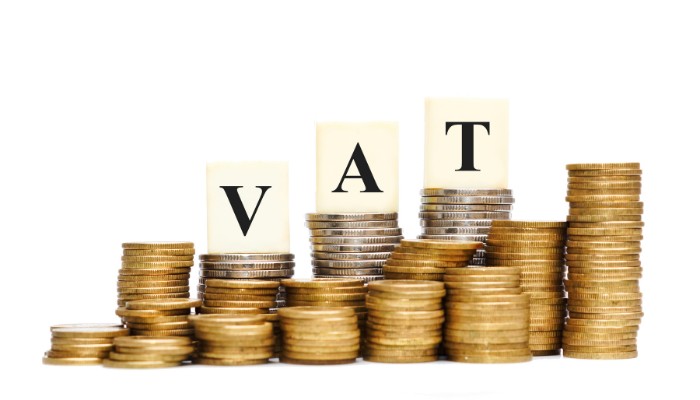When navigating the complexities of international business and taxation, the term “VAT ID” often arises. But What Is A Vat Id, and why is it crucial for businesses operating globally? While the United States doesn’t directly use a Value Added Tax (VAT) system, understanding VAT IDs is essential for US companies engaging in international trade or dealing with VAT-registered entities abroad. This article will delve into the concept of VAT IDs, their purpose, and how they relate to the US tax system.
 Value Added Tax (VAT) explained through a graphic representation of taxes added at each stage of production
Value Added Tax (VAT) explained through a graphic representation of taxes added at each stage of production
Demystifying the VAT ID
A VAT ID, or Value Added Tax Identification Number, is a unique identifier used in countries that implement a VAT system. This system is common in the European Union (EU) and many other countries worldwide. The VAT ID serves as a business’s tax identification number for VAT purposes, allowing them to:
- Charge VAT on goods and services they sell.
- Reclaim VAT on goods and services they purchase for their business.
- Engage in cross-border transactions within VAT-regulated regions.
Think of it as a passport for businesses within a VAT system, enabling them to navigate the complexities of value-added taxation.
VAT IDs vs. US Tax IDs: A Key Difference
The United States operates under a different tax structure than countries with VAT systems. Instead of VAT, the US primarily relies on sales tax at the state level and federal income tax. Therefore, US companies do not have a VAT ID in the same way that European businesses do.
However, US businesses do have other forms of tax identification, the most important of which are:
- Employer Identification Number (EIN): Issued by the Internal Revenue Service (IRS), the EIN is a nine-digit number assigned to businesses for tax reporting purposes. It is used to identify a business entity for federal tax purposes.
- Taxpayer Identification Number (TIN): This is a generic term that can refer to either an EIN (for businesses) or a Social Security Number (SSN) for individuals.
While these IDs serve a similar purpose to VAT IDs – identifying taxpayers and facilitating tax compliance – they operate within a different tax framework.
How to Find Your US Tax ID
If you’re a US business and need to find your EIN, you can typically locate it on previous tax returns, official IRS correspondence, or bank statements associated with your business account. If you can’t find it, you can contact the IRS directly to request confirmation of your EIN.
Do US Companies Need VAT IDs?
Generally, if your business operates solely within the United States, you do not need a VAT ID. However, the situation changes if you:
- Sell goods or services to customers in VAT-registered countries: You may be required to register for VAT in those countries and obtain a VAT ID.
- Purchase goods or services from VAT-registered businesses: You may need to provide your US tax information to avoid being charged VAT, although this doesn’t constitute having a VAT ID.
- Operate a business with a physical presence in a VAT-registered country: You will likely need to register for VAT in that country.
Navigating VAT for US Businesses
For US companies involved in international transactions with VAT-registered entities, understanding VAT rules is crucial. Here’s how you can navigate the VAT landscape:
- Determine if VAT registration is required: Assess your sales volume and business activities in each country to determine if you meet the threshold for VAT registration.
- Register for VAT in the relevant countries: Follow the registration procedures outlined by each country’s tax authority. This typically involves providing business information and financial data.
- Collect VAT on sales: Charge VAT on taxable goods and services sold to customers in VAT-registered countries. The VAT rate will vary depending on the country and the type of product or service.
- Reclaim VAT on purchases: If you’re VAT-registered, you can typically reclaim VAT on eligible business expenses incurred in VAT-registered countries.
- File VAT returns: Submit regular VAT returns to the tax authorities in each country where you’re registered, reporting your VAT collected and VAT reclaimed.
Verifying VAT Numbers
When dealing with VAT-registered businesses, it’s important to verify their VAT ID to ensure its validity. For EU companies, you can use the VAT Information Exchange System (VIES) to check VAT numbers. For non-EU countries, you’ll need to consult the specific country’s tax authority website.
VAT Refunds for US Travelers: Myth vs. Reality
It’s a common misconception that US tourists can claim a VAT refund on purchases made abroad. While some countries offer VAT refunds to non-resident visitors, the United States does not participate in this practice. If you’re traveling abroad, research the VAT refund policies of the countries you’re visiting. The foreign country in which you paid the VAT is responsible for refunding the tax.
How to Calculate VAT Input and Output
Understanding how to calculate VAT input and output is essential for businesses operating in VAT systems.
- VAT Output: This is the VAT you charge on your sales. To calculate it, apply the appropriate VAT rate to the selling price of your goods or services.
- VAT Input: This is the VAT you pay on your business purchases. Keep track of all invoices from suppliers that include VAT. Sum up the VAT amounts to determine the total input VAT.
The difference between your VAT output and VAT input determines whether you owe VAT to the tax authorities or are eligible for a refund.
Balancing Input and Output VAT
Businesses can offset the input VAT they have paid against the output VAT they collect. If your input VAT is greater than the output VAT, you might be eligible for a VAT refund. Accurate tracking and balancing of VAT are crucial. Errors can result in significant penalties or missed opportunities for refunds, affecting overall profitability.
Seeking Expert Guidance
Navigating the intricacies of VAT can be challenging, especially for US businesses expanding internationally. Consulting with a tax advisor specializing in international VAT compliance can provide valuable assistance. They can help you determine your VAT obligations, register for VAT in the relevant countries, and ensure you comply with all applicable regulations.
Conclusion
While the United States does not have a VAT ID system like many other countries, understanding VAT is crucial for US businesses operating internationally. By grasping the concept of VAT IDs, their purpose, and how they differ from US tax IDs, you can navigate the complexities of global commerce with confidence. Whether you’re selling goods to customers in Europe or purchasing services from VAT-registered businesses, knowing the ins and outs of VAT will help you stay compliant and maximize your business opportunities. Remember to seek expert guidance when needed to ensure you’re meeting all your VAT obligations.
